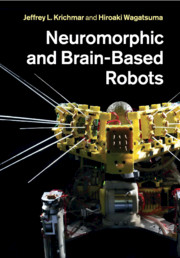Book contents
- Frontmatter
- Contents
- Contributors
- Preface
- Part I Introduction
- Part II Neuromorphic robots: biologically and neurally inspired designs
- 2 Robust haptic recognition by anthropomorphic robot hand
- 3 Biomimetic robots as scientific models: a view from the whisker tip
- 4 Sensor-rich robots driven by real-time brain circuit algorithms
- Part III Brain-based robots: architectures and approaches
- Part IV Philosophical and theoretical considerations
- Part V Ethical considerations
- Index
- References
2 - Robust haptic recognition by anthropomorphic robot hand
from Part II - Neuromorphic robots: biologically and neurally inspired designs
Published online by Cambridge University Press: 05 February 2012
- Frontmatter
- Contents
- Contributors
- Preface
- Part I Introduction
- Part II Neuromorphic robots: biologically and neurally inspired designs
- 2 Robust haptic recognition by anthropomorphic robot hand
- 3 Biomimetic robots as scientific models: a view from the whisker tip
- 4 Sensor-rich robots driven by real-time brain circuit algorithms
- Part III Brain-based robots: architectures and approaches
- Part IV Philosophical and theoretical considerations
- Part V Ethical considerations
- Index
- References
Summary
Introduction
We can easily manipulate a variety of objects with our hands. When exploring an object, we gather rich sensory information through both haptics and vision. The haptic and visual information obtained through such exploration is, in turn, key for realizing dexterous manipulation. Reproducing such codevelopment of sensing and adaptive/dexterous manipulation by a robotic hand is one of the ultimate goals of robotics, and further, it would be essential for understanding human object recognition and manipulation.
Although many robotic hands have been developed, their performance is by far inferior to that of human hands. One reason for this performance difference may be due to differences in grasping strategies. Historically, research on robotic hands has mainly focused on pinching manipulation (e.g. Nagai and Yoshikawa, 1993) because the analysis was easy with point-contact conditions. Based on the analysis, roboticists applied control schemes using force/touch sensors at the fingertips (Kaneko et al., 2007; Liu et al., 2008). Since the contact points are restricted to the fingertips, it is easy for the robot to calculate how it grasps an object (e.g. a holding polygon) and how large it should exert force based on friction analysis. However, the resultant grasping is very brittle since a slip of just one of the contacting fingertips may lead to dropping the object.
Information
- Type
- Chapter
- Information
- Neuromorphic and Brain-Based Robots , pp. 11 - 22Publisher: Cambridge University PressPrint publication year: 2011
